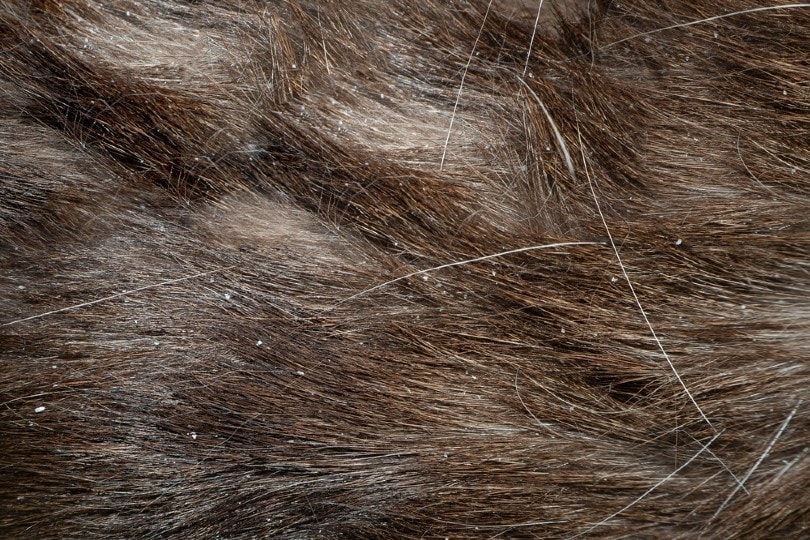Can You Be Allergic to Some Cats but Not Others? Facts & Care Tips

Updated on

Click to Skip Ahead
People with allergies to cats have reactions to a specific protein known as Fel d1. All cats produce this protein so, strictly, if you have a cat allergy you are allergic to all cats. However, some cats produce more of the protein than others, so you may experience fewer allergic symptoms around certain cats. The protein is found in saliva, dander, and urine, so low-shedding cats may leave less dander and fur on furniture, reducing ambient exposure to the protein.
Below, we take an in-depth look at cat allergies and what you can do to minimize the effects if you are an allergy sufferer.
What Causes Cat Allergies?
Cat allergies are caused by a protein that is present in a cat’s saliva, urine, and dander. If you have litter trays in the house, coming into contact with the tray, or even being close to it could cause an allergic reaction. It isn’t the fur itself that causes reactions, it is the saliva on the fur, the dander (dried flakes of skin, similar to dandruff) and the urine. Dander is most likely to fall off a cat’s fur when they molt or shed their fur, so cats that are prone to shedding can be more likely to cause reactions, but this doesn’t seem to always be the case. Cats that are itchy due to fleas or because they have allergies themselves will tend to scratch, causing the release of more dander.

Symptoms
Cat allergies cause typical allergic reactions, similar to those caused by any type of allergy.
- Sneezing
- Coughing
- Runny nose
- Eye irritation
- Blocked nose
- Tight chest
- Wheezing
- Skin inflammation
- Eczema
- Rash
Breathing problems associated with allergic reactions are more common in allergy sufferers with asthma but can occur in young and old people, as well as those with weakened immune systems.
Diagnosis
While it might seem obvious that allergic reactions you’re experiencing are being caused by exposure to cats, it is worth visiting a doctor for diagnosis, because they could be caused by another environmental or even food-based allergy. The most common method of diagnosis is a skin prick test where an extract of cat allergen is put on your finger and then your finger is pricked to allow the allergen to seep under the skin’s surface. You are then monitored for reactions over the next 15-20 minutes. This technique can be used to eliminate other possible causes and determine whether you are allergic to cats.

Treatment
Treatment for cat allergies includes antihistamines, decongestants, and steroid nasal sprays. These are used to control the symptoms of the allergy and there is no treatment to cure an allergy.
Top 7 Tips for Allergy Sufferers
While there is no cure for a cat allergy, there are medications that can help combat the symptoms, and there are some steps you can take to help minimize the effects of an allergic reaction.
1. Reduce Exposure
Minimize exposure to allergens by reducing the time you spend around cats. Avoid kissing, hugging, or holding them. If you have a severe allergy, you may also need to take care of other people that own cats. They can transfer dander that will cause allergic reactions.
2. Choose a Low Shedding Cat
Although it isn’t the fur that causes allergic reactions, fur carries dander and because fur gets on furniture, clothes, and floors, more fur can mean more allergic reactions and more severe symptoms. Hairless cats like the sphynx obviously don’t shed while breeds including the Devon Rex, Cornish Rex, and Russian Blue are known to shed less than others.

3. Meet Cat Breeds Before Buying
Some cats cause fewer allergic reactions than others. If you want to ensure that a cat you choose isn’t going to cause you a severe reaction, meet it before buying or adopting.
4. Vacuum Regularly
Vacuuming the house, or sweeping and mopping the floors, will help remove hair, dander, and other sources of the proteins that cause allergic reactions. Removing hair from furniture and floors is a good way to minimize exposure to fur and dander.
5. Use HEPA Air Filters
HEPA air filters remove tiny particles from the air, including dust particles, dander, and hair. You can buy portable air filters, and have them installed in an HVAC (heating, ventilation and air conditioning) system, or you can buy vacuums and other appliances that include HEPA filters. Research suggests that the amount of dander and allergen in the air is reduced with the use of HEPA filters but that this doesn’t correspond to a reduction in allergic signs exhibited by members of the household. More research is needed into HEPA filters and cat allergies.

6. Brush Cats Regularly
Brushing a cat gets rid of dead hair and dander, which minimizes shedding in the house on furniture and floors. Ideally, you should get somebody else to do the brushing and have them brush the cats outside so that you aren’t exposed to giant balls of protein-covered fur.
7. Install Hardwood Floors
Cat fur and dander get trapped in carpet and rug piles. You could always consider getting rid of the rugs in the hallways and having hardwood floors instead of carpets. These are easier to keep free of cat fur.
Can You Overcome a Cat Allergy?
There is no cure for cat allergies, unfortunately. However, you can have a course of immunotherapy jabs that help desensitize a person to the allergen with the hope of minimizing the symptoms you suffer. And some allergy sufferers find that allergies do subside over time, but there is no guarantee.
Can I Build an Immunity to a Cat Allergy?
Increased exposure to cats won’t cure the allergy and will only cause an increase in the number and severity of allergic reactions you suffer. Immunotherapy can help build immunity. This means having a course of injections over 6 months and then regular booster injections.
Conclusion
Pet allergies are extremely common, and cat allergies are the most common of all. Exposure to cats and their urine, dander, and saliva, can lead to symptoms ranging from a runny nose to difficulty breathing.
Although all cats produce the protein that causes reactions, meaning that sufferers are allergic to all cats, those that shed less and produce less dander tend to elicit fewer and less severe allergic reactions, which can explain why you might suffer reactions around some cats but not others.
Featured Image Credit: Image Point Fr, Shutterstock












